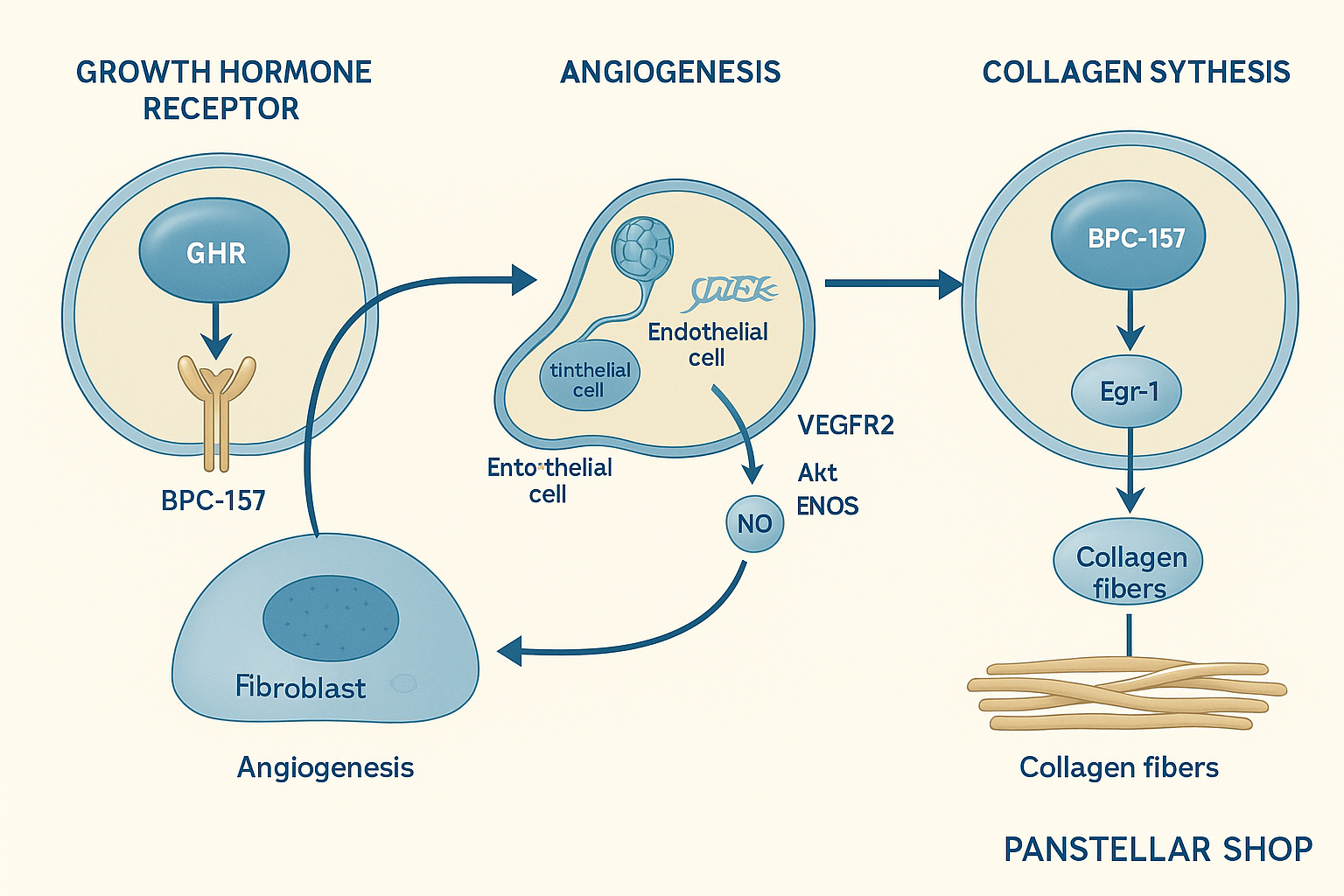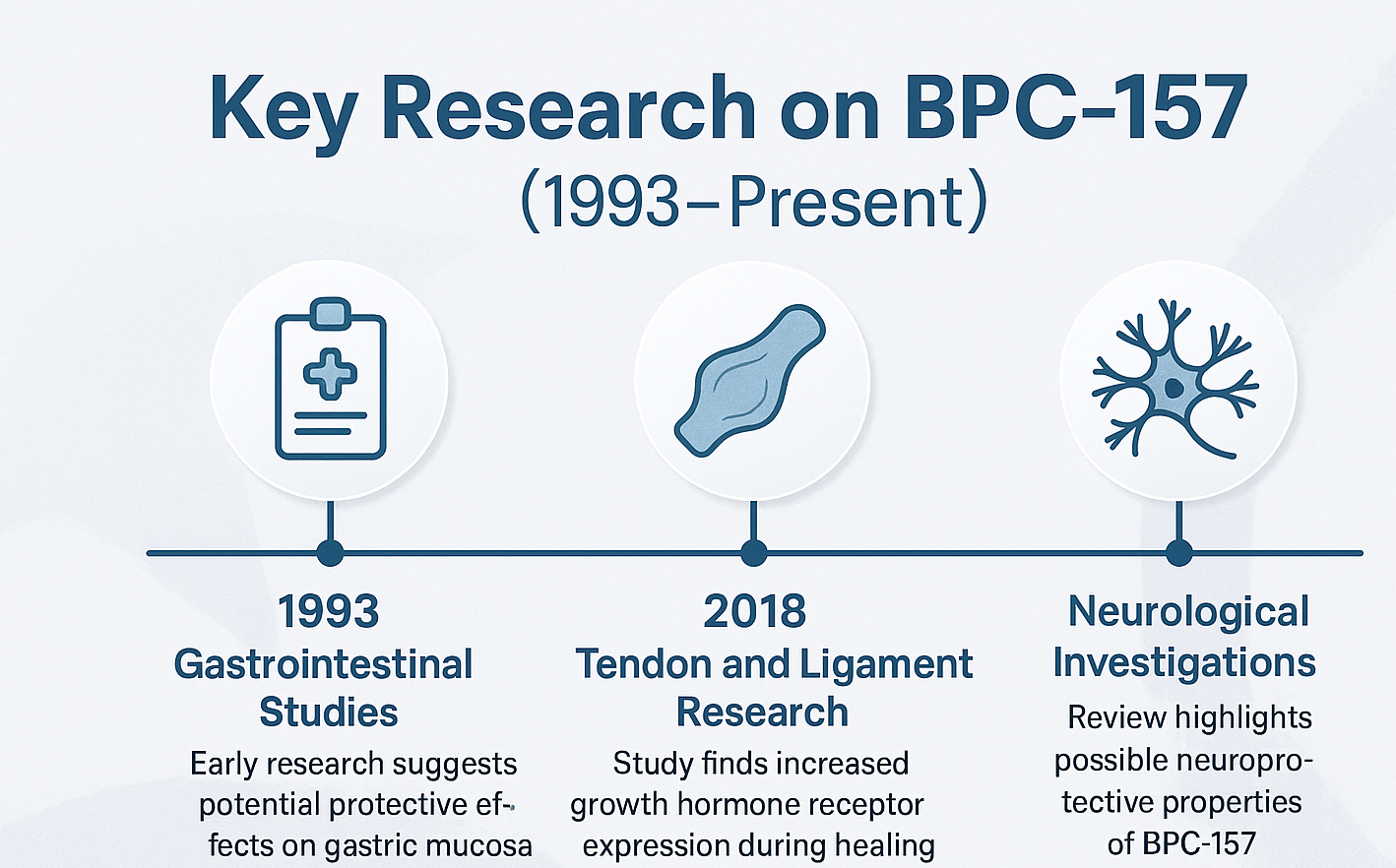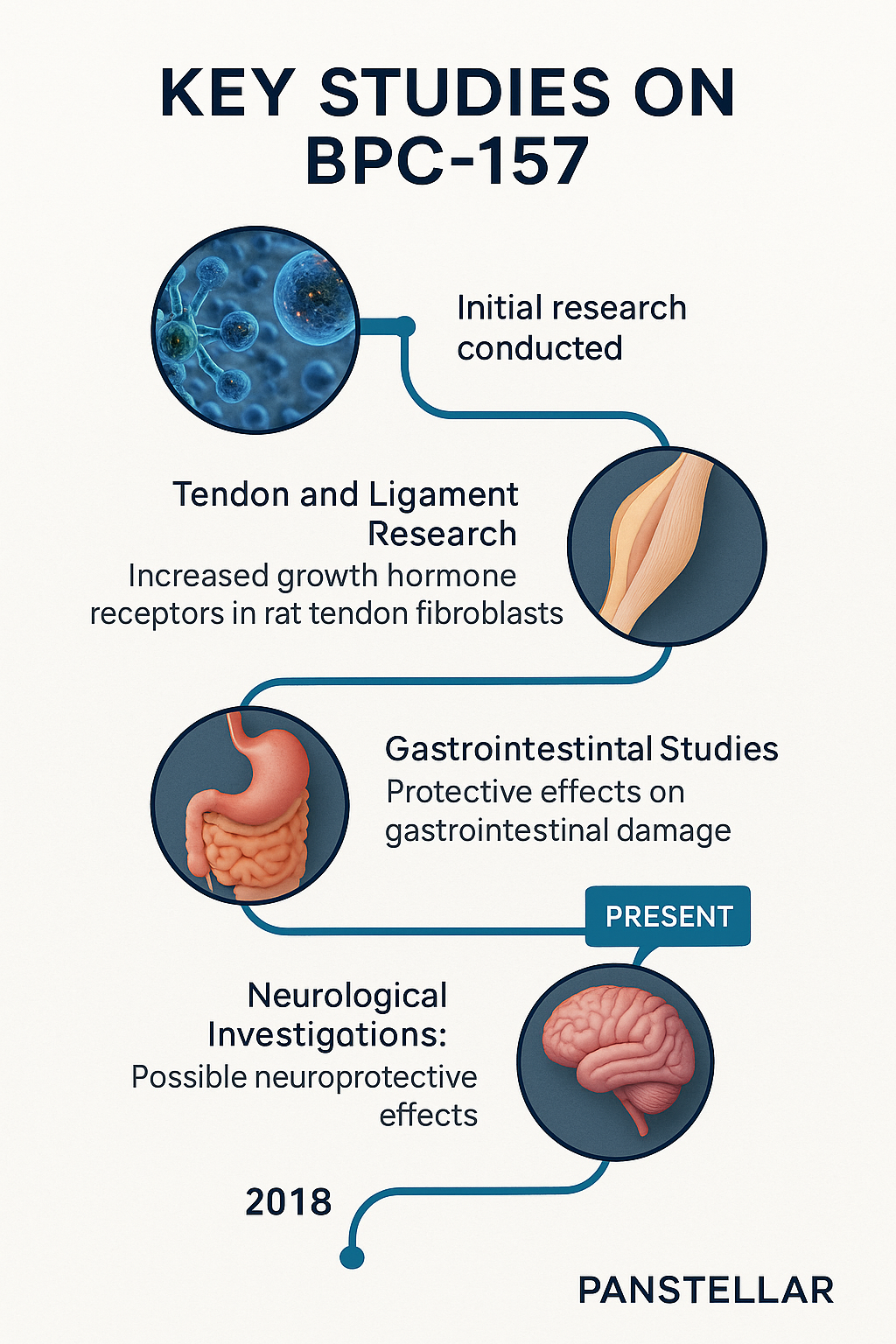In the rapidly evolving field of peptide research, BPC-157 has emerged as a compound of significant scientific interest. This 15-amino acid peptide, derived from a protective protein found in gastric juice, has captured attention in research communities and among health enthusiasts. While preliminary research shows potential, it’s essential to understand what the current scientific evidence actually reveals about this experimental compound.
I- What is BPC-157 and How Does It Work?

BPC-157, officially known as Body Protection Compound-157, is a synthetic pentadecapeptide composed of 15 amino acids. First described in scientific literature in 1993, this peptide was isolated from a protective protein found in human gastric juice. Its amino acid sequence (Gly-Glu-Pro-Pro-Pro-Gly-Lys-Pro-Ala-Asp-Asp-Ala-Gly-Leu-Val) gives it unique properties that have made it a subject of scientific inquiry.
What distinguishes BPC-157 from many other peptides is its remarkable stability. Unlike many peptides that rapidly degrade in the digestive tract, BPC-157 demonstrates resistance to enzyme degradation and remains stable in gastric acid. This unusual stability has led researchers to investigate its potential effects when administered both orally and through injection.
The proposed mechanisms of BPC-157 center around tissue healing processes. Laboratory research suggests that the peptide may influence several key pathways involved in tissue repair:
- Growth factor expression: Studies on tendon fibroblasts indicate BPC-157 may increase growth hormone receptor expression, potentially enhancing the body’s response to growth factors involved in healing processes.
- Angiogenesis promotion: Research suggests the peptide might stimulate the formation of new blood vessels, an essential component of tissue repair.
- Collagen synthesis: Laboratory studies indicate BPC-157 may support fibroblast function and collagen production, critical elements in tissue regeneration.
II- Current Research Status: What Science Actually Shows
The scientific interest in BPC-157 has led to numerous preclinical studies, primarily in animal models. These studies have explored its potential effects across various tissue types and injury models.

A- Tendon and Ligament Research
One area of significant research focus has been tendon and ligament healing. A 2018 study published in the journal Molecules examined the effect of BPC-157 on tendon fibroblasts isolated from rat Achilles tendons. The researchers found that BPC-157 increased the expression of growth hormone receptors in these cells, suggesting a potential mechanism for enhanced healing response.
B- Gastrointestinal Studies
Given its gastric origin, BPC-157 has been extensively studied in gastrointestinal models. Early research published in the Journal of Physiology investigated its effects on various experimental models of gastrointestinal damage. These studies suggest potential protective effects on gastric mucosa, though the exact mechanisms remain under investigation.
C- Neurological Investigations
More recent research has begun exploring BPC-157‘s potential effects on the nervous system. A 2021 review in Neural Regeneration Research highlighted studies examining the peptide’s effects in various neurological models, suggesting possible neuroprotective properties that warrant further investigation.
- Regulatory status: BPC-157 has not been approved for human use by major regulatory bodies like the FDA. The FDA has specifically stated that there is insufficient data to assess its safety in humans.
- Methodological issues: Many studies on BPC-157 have methodological limitations, including small sample sizes and lack of appropriate controls.
III- Potential Applications Under Investigation

Based on preclinical research, scientists have identified several areas where BPC-157 might warrant further investigation, though it’s crucial to emphasize that these applications remain experimental and unproven in humans.
A- Tissue Regeneration Models
Laboratory and animal studies suggest this peptide may influence tissue repair mechanisms. Research published in the Journal of Physiology has examined its effects on various injury models, including tendon, muscle, and bone healing. These studies suggest potential acceleration of the healing process, though human studies are lacking.
B- Gastrointestinal Research
Given its origin from a gastric protein, BPC-157 has been studied extensively in gastrointestinal models. Early research indicates potential protective effects against various forms of gastrointestinal damage, though the translation to human applications remains uncertain.
C- Inflammatory Response Studies
Some research indicates BPC-157 may influence inflammatory pathways. A review published in Current Pharmaceutical Design highlighted studies suggesting anti-inflammatory effects in various experimental models, though the clinical significance of these findings requires further investigation.
IV- Safety Considerations and Regulatory Status of BPC-157
The safety profile of it in humans remains largely unknown due to the lack of comprehensive clinical trials. This knowledge gap presents significant concerns that must be carefully considered.
A- Current Regulatory Position of BPC-157
Major regulatory agencies, including the FDA, have not approved this for human use. The FDA has specifically noted concerns about the peptide, stating there is insufficient data to assess its safety in humans. Additionally, the World Anti-Doping Agency (WADA) has classified BPC-157 as a prohibited substance under the S0 category of non-approved substances.
B- Potential Risks Under Investigation
Without comprehensive human trials, the full spectrum of potential risks remains unclear. Concerns that researchers have identified include:
- Immune reactions: The FDA has noted that peptides like this may trigger immune system reactions
- Unknown long-term effects: The absence of long-term studies means potential delayed effects remain uncharacterized
- Variable product quality: As an unregulated substance, the purity and consistency of commercially available products cannot be guaranteed
V- Future Research Directions
The scientific community continues to investigate BPC-157, with several important research directions emerging:
A-Need for Human Clinical Trials
The most pressing research need is for well-designed, controlled human clinical trials. Such studies would need to establish basic safety parameters, appropriate dosing, and efficacy for specific applications before any clinical use could be considered.
B- Mechanism Elucidation
While several potential mechanisms have been proposed for BPC-157‘s effects, much remains unknown about exactly how it influences cellular processes. Future research should focus on clarifying these mechanisms to better understand its potential applications.
C- Standardization Studies
If BPC-157 is to progress toward legitimate medical applications, studies establishing standardized production methods, quality control parameters, and reliable testing protocols will be essential.
Conclusion: A Perspective Based on Current Evidence
BPC-157 represents an interesting case study in the translation of laboratory research to clinical applications. While preliminary studies suggest potential in various healing processes, the significant gap between laboratory findings and proven human applications must be emphasized.
The current scientific consensus maintains that this peptide remains an experimental compound that requires substantial additional research before any conclusions about its safety or efficacy in humans can be drawn. Individuals considering its use should be aware that they are essentially participating in an uncontrolled experiment with unknown risks.
For those interested in tissue healing and regenerative approaches, numerous evidence-based options exist with established safety and efficacy profiles. These include physical therapy, proper nutrition, adequate rest, and FDA-approved medical interventions when appropriate.
The scientific exploration of this kind of peptide may eventually yield valuable therapeutic approaches, but only through rigorous research conducted according to established scientific and ethical standards. Until such research is completed, caution and skepticism remain the most appropriate response to claims about this experimental peptide.
References
- Chang CH, Tsai WC, Lin MS, Hsu YH, Pang JH. The promoting effect of pentadecapeptide BPC 157 on tendon healing involves tendon outgrowth, cell survival, and cell migration. J Appl Physiol. 2011. https://journals.physiology.org/doi/full/10.1152/japplphysiol.00945.2010
- Sikiric P, Seiwerth S, Rucman R, et al. Stable gastric pentadecapeptide BPC 157: novel therapy in gastrointestinal tract. Curr Pharm Des. 2011. https://pubmed.ncbi.nlm.nih.gov/21548867/
- Seiwerth S, Sikiric P, Grabarevic Z, et al. BPC 157’s effect on healing. J Physiol Paris. 1997. https://www.sciencedirect.com/science/article/abs/pii/S0928425797891506
- U.S. Anti-Doping Agency. BPC-157: Experimental Peptide Creates Risk for Athletes. 2023. https://www.usada.org/spirit-of-sport/bpc-157-peptide-prohibited/
- Gwyer D, Wragg NM, Wilson SL. Gastric pentadecapeptide body protection compound BPC 157 and its role in accelerating musculoskeletal soft tissue healing. Cell Tissue Res. 2019. https://pubmed.ncbi.nlm.nih.gov/30623273/
- Krivic A, Majerovic M, Jelic I, Seiwerth S, Sikiric P. Modulation of early functional recovery of Achilles tendon to bone unit after transection by BPC 157 and methylprednisolone. Inflamm Res. 2008. https://pubmed.ncbi.nlm.nih.gov/18661274/
- Cerovecki T, Bojanic I, Brcic L, et al. Pentadecapeptide BPC 157 (PL 14736) improves ligament healing in the rat. J Orthop Res. 2010. https://pubmed.ncbi.nlm.nih.gov/20225319/
- Tkalcevic VI, Cuzic S, Brajsa K, et al. Enhancement by PL 14736 of granulation and collagen organization in healing wounds and the potential role of egr-1 expression. Eur J Pharmacol. 2007. https://pubmed.ncbi.nlm.nih.gov/17383608/